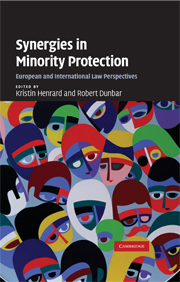Book contents
- Frontmatter
- Contents
- Foreword
- Abbreviations
- 1 Introduction
- PART A Minorities-specific instruments, provisions and institutions
- PART B Non-minorities-specific instruments, provisions and institutions
- 7 Developments relating to minorities in the law on genocide
- 8 The United Nations International Covenant on Economic, Social and Cultural Rights
- 9 The United Nations International Convention on the Elimination of All Forms of Racial Discrimination
- 10 The United Nations Convention on the Rights of the Child and Children Belonging to Minority Groups
- 11 UNESCO's Convention Against Discrimination in Education
- 12 A patchwork of ‘successful’ and ‘missed’ synergies in the jurisprudence of the ECHR
- 13 The many faces of minority policy in the European Union
- 14 Developments under the African Charter on Human and Peoples' Rights relevant to Minorities
- 15 Regional cooperation and minority issues in the Asia-Pacific region
- Index
- References
8 - The United Nations International Covenant on Economic, Social and Cultural Rights
from PART B - Non-minorities-specific instruments, provisions and institutions
Published online by Cambridge University Press: 21 July 2009
- Frontmatter
- Contents
- Foreword
- Abbreviations
- 1 Introduction
- PART A Minorities-specific instruments, provisions and institutions
- PART B Non-minorities-specific instruments, provisions and institutions
- 7 Developments relating to minorities in the law on genocide
- 8 The United Nations International Covenant on Economic, Social and Cultural Rights
- 9 The United Nations International Convention on the Elimination of All Forms of Racial Discrimination
- 10 The United Nations Convention on the Rights of the Child and Children Belonging to Minority Groups
- 11 UNESCO's Convention Against Discrimination in Education
- 12 A patchwork of ‘successful’ and ‘missed’ synergies in the jurisprudence of the ECHR
- 13 The many faces of minority policy in the European Union
- 14 Developments under the African Charter on Human and Peoples' Rights relevant to Minorities
- 15 Regional cooperation and minority issues in the Asia-Pacific region
- Index
- References
Summary
Introduction
In contrast with the International Covenant on Civil and Political Rights (the ‘ICCPR’) discussed in Chapter 2, its twin, the International Covenant on Economic, Social and Cultural Rights (the ‘ICESCR’ or simply ‘the Covenant’) contains no explicit reference to minorities. This is surprising, given that the concern of the ICESCR with cultural protection would more immediately bring minority protection concerns to mind. In the absence of an explicit reference to minorities, the initial question arises of whether the ICESCR is relevant to minority protection and what kind of protection the ICESCR grants.
Persons belonging to minorities and minority groups would appear to be, by their very nature, likely victims of the violations of the rights which the ICESCR enshrines. The importance of the inclusion of the minority concept under the Covenant would further reside in the fact that especially economic and social aspects of minority protection remain the least developed, both conceptually and in practice. Hence, from a human rights perspective, these are the aspects which demand a higher degree of attention and reference points as to their interpretation.
From the perspective of cultural protection, aspects of human rights protection which normally feature in international minority protection standards, such as the protection of language and educational rights and of national, ethnic, religious and linguistic identity are sometimes comprised in definitions of culture. However, even the term ‘culture’ is not clear-cut, but has been attributed a variety of meanings.
- Type
- Chapter
- Information
- Synergies in Minority ProtectionEuropean and International Law Perspectives, pp. 213 - 248Publisher: Cambridge University PressPrint publication year: 2009



